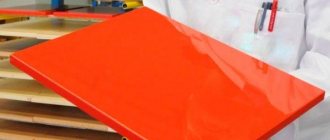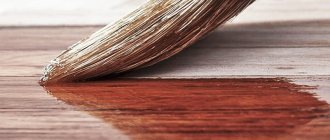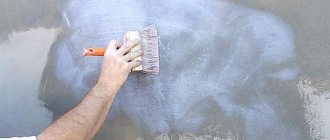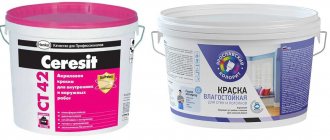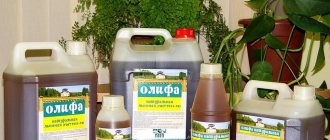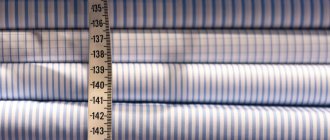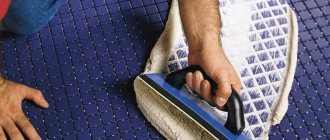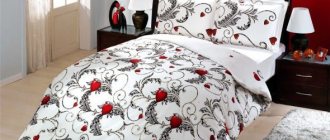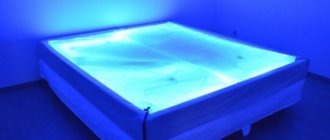The parameter “ Concrete contact consumption ” significantly depends on the porosity of the surface on which it is applied.
Basically, Betonokontakt is used for priming concrete surfaces (hence its name), but can also be applied to other surfaces: brick, drywall, concrete and ceramic tiles, old paint, etc. But even for one type of surface (for example, concrete) the consumption concrete contact can vary significantly.
Price of concrete contact, properties and characteristics, application instructions: Concrete contact
Concrete contact primer: features and consumption per 1m2
A primer is a unique solution that is used to prepare a specific surface for finishing, such as painting.
The use of such a building mixture allows you to level the surface, get rid of any defects on the wall and eliminate small cracks. One of the most popular types of primer is concrete contact, the use of which greatly simplifies further finishing work.
Main characteristics and properties
Concrete contact is a building mixture based on acrylic, which also includes cement, sand and special additives. This mixture is actively used to increase the adhesion of surfaces that do not absorb moisture well, before plastering, laying tiles and carrying out other finishing work.
Among its main advantages are the following:
- high drying speed. Further finishing work can begin a few hours after applying the primer;
- resistance to moisture. During the drying process, a special film is formed that does not allow water to pass through;
- durability. According to the manufacturing company, the concrete contact primer does not lose its qualities for 80 years.
Thanks to its unsurpassed properties, concrete contact has established itself as a unique material that is durable, does not require a lot of drying time and does not allow moisture to pass through. It is these properties that allow you not to worry about the quality of the repairs done.
How to determine the consumption of concrete contact?
The consumption of concrete contact per 1 m2 depends on many factors, among which the first place is occupied by the characteristics of the treated surface
It is not the type of surface itself that is important, but the porosity. It determines how much primer will be absorbed, which has a direct impact on its consumption per m2
Consumption table for concrete contact primer from different manufacturers
Depending on the porosity, the following types of surfaces are distinguished:
- Porous surfaces, which include brick or sand concrete. The primer is absorbed quite intensively, which leads to consumption of concrete contact up to 0.5 kg per m2. If the porosity is too large, then you will first need to treat the surface using special solutions.
- Surfaces with medium porosity. These include concrete and concrete tiles. Concrete contact consumption is about 0.3 kg per m2.
- Low-porous surfaces for which primer consumption is minimal - 0.1-0.2 kg per m2.
Is it possible to reduce primer consumption?
Most people wonder whether it is possible to reduce the consumption of concrete contact primer. The answer is definitely no. First of all, this building mixture has an affordable price, so there is no point in saving on it. In addition, this can cause the material to decrease in strength, which will begin to crack or peel over time.
It should be remembered that the quality of the primer and the work done to apply it has a direct impact on future finishing work and the quality of the entire repair as a whole. If you reduce the amount of concrete contact primer per m2, the surface will lose its ability to adhere. This may cause the coating to separate from the substrate in the future.
Reducing primer consumption may result in loss of surface adhesion
The primer plays an important role in the process of ensuring waterproofing of the surface, which can be compromised when the amount of solution per m2 is reduced
We should also not forget about an important feature of some finishing materials, which is that some coatings can dry out. The fact is that they contain gypsum or Portland cement, and drying out becomes a natural reaction to a decrease in the amount of water
Thus, the use of concrete contact is important for the future of all repairs
All the nuances of using this building mixture should be taken into account. The consumption level of concrete contact per m2 depends on the type of base and its porosity
You should not save when using a primer, as this can negate all further finishing work.
This is interesting: Do-it-yourself renovation of a small kitchen in Khrushchev
Mixture consumption
The consumption of high-quality Knauf concrete contact per 1 m2 is a very important and pressing issue. Professionals, and even those who have at least once worked with similar compositions, will definitely say that this indicator is determined by the type of surface, its initial condition and the level of moisture absorption.
When analyzing construction practice (on average), the following figures were obtained:
- Consumption for brick, sand concrete and porous concrete is 500 g per 1 sq. m. Costs can be reduced if you use impregnations that penetrate deeply into the material.
- First-class monolithic concrete is primed in an amount of 350 g per 1 sq. m, provided that the pore size is average.
- When there are few pores or the surface is already covered with paint, you can use only 150-250 g of primer to cover 1 sq. m.
In order for adhesion to be fully ensured, the condition of the original wall surface must also be taken into account. If gaps are discovered during the work or the base very greedily absorbs the finishing material, it can be coated again, but only after the initially applied mixture has completely dried.
Determining exactly how much primer will have to be spent is not so difficult. Its small volume is weighed in a pallet and distributed over an area of 1 sq. m on walls and ceilings.
Home craftsmen and even experienced professionals are naturally interested in whether it is possible to deviate from the recommended figures and use less concrete contact. As practice shows, this is a big mistake: the cost of purchasing a primer is relatively small, and its lack impairs the quality of preparation. The layer created will be fragile - it can crack and delaminate. The worst thing is that then it will not be possible to achieve a normal level of adhesion with the main finish.
Then even the best primer will not be able to prevent the plaster from falling off or the paint from cracking. We will have to redo all the work and again invest in the purchase of finishing and preparatory materials.
First, concrete contact can be mixed with deeply penetrating mixtures, and then it can only be used in its pure form. When using a spray gun, the total primer consumption increases slightly. The manufacturer recommends waiting 12 hours for drying (this time is the maximum). If the temperature and humidity conditions are favorable, you can wait only 3-4 hours. When using hand tools, concrete contact should not be diluted with water, but if it is sprayed mechanically, the solution is made in a ratio of 2: 1.
Primer properties
Knauf Betokontakt not only strengthens weak surfaces and increases the adhesion of smooth substrates before plastering. The ability of the acrylic mixture to clog pores and microcracks makes it possible to reduce the consumption of viscous (liquid) finishing materials and retain the water in leveling solutions necessary for their normal setting. Thanks to this, the plaster does not delaminate or crack due to rapid loss of moisture.
The performance characteristics of the Knauf mixture are also worthy of attention. For example, its formula already includes fungicidal additives, which means that additional antiseptic treatment is no longer required. Concrete contact itself does an excellent job of protecting walls from mold, reducing your repair costs. To this it is worth adding the good vapor permeability of the created intermediate layer - it does not interfere with diffusion air exchange between the room and the street.
In some ways, the disadvantage of the primer is the need to quickly begin further work as soon as Betonokontakt Knauf dries. It is impossible to postpone finishing, much less carry out other activities in the room at the same time - a rough adhesive layer easily accumulates dust, worsening the properties of the preparation.
Characteristics and consumption
The Betonokontakt primer from the Knauf company is produced with a mineral filler of two fractions, on which the scope of application of a particular composition depends:
- 0.6 mm – used before rough thick-layer leveling;
- 0.3 mm - it is worth purchasing for preparing plastered surfaces before puttying.
The pink pigment introduced into the composition allows you to control the application and not miss a single area during processing.
Knauf technical characteristics:
- Acidity – neutral (pH 7.5-8.5).
- The drying time of the layer is from 3 hours, depending on the humidity and temperature in the room.
- Service life – up to 80 years. Although the material is still too “young” to confirm or refute the manufacturer’s statements.
- Wide temperature range of application - according to its characteristics, Concrete Contact can be called a primer for interior and exterior work. After drying, it retains its properties at -40..+60 °C, withstanding at least 5 freeze-thaw cycles.
- Possibility of application in any convenient way (brush, brush, roller, mechanical spraying).
- Absolutely environmentally friendly - the use of adhesive primer is allowed even in poorly ventilated areas and does not require respiratory protection. Its formula simply does not contain toxic solvents that can harm humans.
The primer consumption depends on the characteristics of the base: smoothness and porosity (absorbency). It will show the minimum result on tiles - 200 g/m2; on monolithic concrete of different densities this figure will increase to 250-350 g/m2.
Recommendations for use
The Knauf primer is completely ready for application. However, before starting, it is recommended to stir it with a drill with a mixer attachment at low speeds so that the fine sand is evenly distributed throughout the entire volume. Work is carried out only after cleaning and removing dust from the base. In this case, the temperature of the wall being treated should be within +5..+30 °C.
Unlike many similar mixtures, here the manufacturer allows the primer to be diluted with water in order to reduce material consumption per 1 m2 and simplify painting of the dispersion composition. However, for manual application the amount of water should not exceed 50 ml/liter. Firstly, a solution that is too thin will not allow you to create a continuous “coat”. Secondly, the sand will quickly settle at the bottom of the container and will have to be constantly stirred.
For soft substrates, as well as application by spraying, the mixture can be diluted with water in a ratio of 2:1. Alternatively, experts recommend using another technology. It allows you to reduce the consumption of Concrete Contact by 1 m2, but still get a high-quality result. Processing is performed in two layers:
Price
Errors at work
Due to inexperience or ignorance, building materials for intermediate installation are often used, making mistakes. The consequences of this can be unpredictable, and it is almost impossible to track the processes of destruction under finishing in a timely manner. This also applies to concrete contact.
In reviews, there is often a remark about adhesives and leveling mixtures that they have poor adhesion to soil with quartz. This is only possible if the solution contains an excess amount of water. This drawback leads to the separation of mixtures due to a disrupted moisture transfer process and a low concentration of the binder component.
Deviations from the declared soil parameters may occur for the following reasons:
- applying the composition at temperatures below +7 – +10°C or above +25°C, at a relative air humidity above 65%;
- processing frozen or wet bases;
- finishing of an unprepared surface (dust, grease stains, affected areas, weak spots);
- inadequate drying of the coating (how long the concrete contact dries depends on the recipe, the original takes only 3-4 hours);
- wind or draft accelerates the process of water loss and the formation of dry residue, but disrupts its quality;
- adding water reduces the concentration of the binder and deteriorates the quality of the adhesive film;
- use of cheap analogues of Betokontakt for “heavy” finishing.
Dust can be invisible, but it actively adheres to the primed surface. The plaster and glue will peel off from such a base. You will have to do the pre-treatment again.
The solid filler is heavier than the other components in concrete contact. It settles relatively quickly to the bottom of any working container. Therefore, it is important to stir the composition periodically.
The original soil is stored in an airtight container for only 2 years, analogues from six months. Mostly natural ingredients will most likely not cause any harm to health after the expiration date.
But quality indicators will noticeably decrease. After sub-zero temperatures during storage, it will be possible to work only with frost-resistant soil. But in any case, it is applied at temperatures above +7 – +10°C to +25°C. This applies to the material, the base and the air.
Recommendations for surgery
In order to do the job flawlessly on the first try, it is better to listen (heed?) to the advice that masters share with beginners.
Purchase and preparation of the composition
- Buying a quality product that has many positive reviews is the only way to protect yourself from all kinds of counterfeits. Checking the packaging (expiration date) and quality certificate “without leaving the checkout” will give you a chance to purchase a fresh and efficiently working product.
- If you are not sure which primer is needed for a particular surface, then it is better to get all the information from sales consultants. They will lay out all the necessary information - about the manufacturer, about the concrete contact: consumption, features of the types available for sale.
- After opening the package, the primer, which is similar in consistency to paint, is also thoroughly mixed, for example, with a mixer attachment. An obstacle to applying concrete contact is a high level of humidity (more than 75%). It will not allow the material to dry “correctly”.
The homogeneity of the mixture is the first sign of a quality product. Any lumps in a freshly opened container indicate the opposite.
Surfaces and work
Betonokontakt does not like greasy stains on the paint, so problem areas are washed (wipe) with a sponge, then degreased. The use of a regular primer will allow you to slightly reduce consumption, since it will do its job - it will fill all the cracks in the base. Large and small debris, dirt, unevenness or suspicious areas that threaten to soon crumble are the obstacles that will have to be gotten rid of. A necessary condition for work is a clean but completely dry base. Surfaces that absorb liquid well are a sufficient reason to apply two layers of concrete contact. If the base has serious defects or unusual relief, then re-processing of this problematic surface is also required. The tool is selected based on convenience and surface area. It can be a roller, brush, spray gun
In the latter case, it is important that the size of the nozzle does not interfere with the exit of the mixture components. Wide brushes are ideal
Rollers, on the contrary, increase consumption by absorbing a large amount of the composition. Mandatory drying of each layer, regardless of their number, is a rule that applies to almost all construction work. However, you should not hesitate to fix the finishing material onto the last dried layer. Otherwise, enough dust will settle on it, and it will reduce the contact strength. Protection of the base from it is necessary. If 48 hours have passed after applying the concrete contact, then a new surface treatment will be required: this time with ordinary deep penetration soil.
If not all of the concrete contact is used, then the packaging is stored at room temperature. Sending it to “winter” on an open balcony is prohibited: since after freezing the primer loses its unique properties. The shelf life of the material is from 6 to 12 months.
Properties and characteristics of concrete contact primer
Compound
Concrete contact is a styrene-acrylic dispersion consisting of water, technological additives, filler and pigment. Concrete contact primer becomes unique due to its special composition, the main role in which is played by fillers with a certain granulometry.
In cheaper domestic mixtures, the fillers are marble flour. And foreign manufacturers prefer to use quartz sand. However, according to the technical characteristics, both compositions are practically indistinguishable in terms of the quality of adhesion.
Adhesive primer is produced in two versions:
- Concrete contact with filler fraction 0.3 mm;
- Soil with a fraction of 0.6 mm.
A large fraction involves the use of soil for rough finishing, which is most often plaster. The 0.3 mm fraction is used for putty.
The composition may vary depending on the form of release:
- ready-made mass, packaged in buckets or barrels,
- dry - in the form of a powder mixture, involving mixing with water.
Application
The concrete contact primer was specially created for treating non-absorbent substrates, such as glass, some paintwork materials, tiles, etc. But this does not exclude its use for other purposes:
- preparing the ceiling for painting;
- reducing porosity and strengthening plasterboard sheets for subsequent finishing;
- surface treatment before applying plaster and putty;
- treating floors before pouring self-leveling coatings or screeds, etc.
Adhesive concrete contact primer has some nuances of use. The soil can only be used at positive ambient temperatures from +5 to +35°C.
Storing open containers at subzero temperatures is also unacceptable. However, this only applies to storage and use. The concrete contact primer, the characteristics of which are presented below, can be used at temperatures from -40 to +50°C.
Specifications
- Maximum fraction size – 0.3 mm, 0.6 mm;
- Complete drying – 3-6 hours;
- Frost resistance – at least 5 cycles;
- pH – 6.9-8.5;
- temperature for work - +5-+30°C;
- temperature for operation – 40-+60°С.
The consumption of concrete contact per 1 m2 ranges from 250 to 400 g, depending on the type of surface and granulometry.
Concrete contact is produced in accordance with GOST 28196-89, where it is classified as a water-dispersion composition with acrylic copolymer.
What not to do
If you wish, you can find reviews or videos that say that the plaster/tiles have fallen off from Betonkontakt. To prevent this from happening, apply primer only to recommended substrates. In addition, you should not do the following things:
- Dilute the plaster or putty composition with more water than indicated on the package. Yes, it’s easier to work with, but as a result, the putty may collapse.
- Do not apply the composition to frozen ground.
- Do not apply Betonokontakt to an unprepared surface (remove all detachable parts, degrease, remove dust).
- Do not apply BC on a damp base. Dry only.
Eskaro produces a primer for non-absorbent rigid substrates with increased water resistance - When working, do not forget to periodically mix the contents, as sand particles (granules from some manufacturers) fall down.
- You cannot continue work until the primer layer has completely dried (indicated in the instructions).
- Do not work at temperatures below +5°C. This does not mean that it cannot be used for outdoor work. It is possible, but it must be applied at positive temperatures.
- Do not allow dust to enter. It sticks very well to the adhesive surface, but then falls off along with the plaster. If the surface is dusty, another treatment is necessary.
- Do not use a composition that has expired or has been frozen. The exception is frost-resistant compounds (there are such). Before use, they must be defrosted, wait until the temperature rises above +5°C, then you can work. By the way, the inscription “frost-resistant” does not mean that it can be applied at sub-zero temperatures. It can only withstand several defrost/freeze cycles before application without loss of properties.
The German company Bergauf also has an acrylic primer Beton Kontakt - Do not add water, even if it seems that the composition is too thick. Unless the manufacturer described this possibility in the instructions. But so far we haven’t seen any of them.
Consumption of concrete contact: how much per 1 m2?
For most people, the word “repair” is unlikely to evoke at least some positive emotions. Usually this process is associated with huge expenses: effort, money and time.
One of those tasks that sometimes causes agony even for people with repair experience, even if not professionals, is the need to increase the adhesion of certain materials. This is where the concrete contact primer comes in handy.
What is concrete contact?
If you are not an experienced builder, then this is probably the first time you have heard this word, so we should figure out what this substance is.
Concrete contact is a special type of primer that can transform absolutely any surface from perfectly smooth to as rough as necessary.
It consists of very strong glue, as well as acrylic and quartz sand. Concrete contact is used for external and internal work. The main manufacturers of this material include Knauf, Prospectors, and Master.
Advantages and disadvantages
This type of primer, like any material, has its pros and cons. Let's look at them in more detail.
- The main positive side of using this primer is that before applying it, you do not have to remove old coatings from the place where you want to apply it.
- You don’t have to use reinforcing mesh during plastering work, and using concrete contact on the plaster will increase its strength, since the solution penetrates into the plaster coating and holds it together. This means that after using concrete contact you will be able, for example, to drill or perform other similar work without fear of significant damage to the finish.
- When working with this substance, you do not need to use special protective equipment, because it is an environmentally friendly substance that does not contain any solvents or other harmful substances that can harm your health.
- Walls treated with concrete contact will not stop “breathing”, and mold and other types of fungi will never appear on them.
Perhaps you will find useful information on how to prime walls for wallpaper. Read this article.
- You cannot store this material in the cold because it will lose its properties.
- If applied incorrectly, it will not perform its basic properties.
Consumption rates
Despite the fact that the name of this material contains the word “concrete,” concrete contact can be used on completely different surfaces.
Accordingly, the rate of its consumption will be completely different. It depends, first of all, on the porosity of the surface on which you apply it.
And although the simplest and most reliable way to determine the rate of consumption of concrete contact is to simply apply it to a part of the desired surface with an area of \u200b\u200bone square meter, let's still consider the approximate rate of consumption of this material.
- On highly porous surfaces, such as concrete slabs, bricks or special porous stones, you should apply 0.5 kg per 1 m2.
- For materials with medium density, such as concrete monolith or concrete tiles, you will need 0.3 kg per 1 m2.
- Low-porous surfaces (ceramics, tiles) will require at least 0.15 kg of concrete contact per 1 m2.
DIY primer application
First you need to clean the surface of debris and dirt, dust and everything else. Next you will need a roller or brush.
It is necessary to carefully place the concrete contact in the container and use a roller to apply it in an even thin layer on the wall. Corners and hard-to-reach places are treated with primer using a brush.
When performing work, you need to monitor the temperature in the room. It should not be below +5 °C.
Now the main job is done and you can rest a little. You must wait until the concrete contact is completely dry
Complete drying of the concrete contact usually occurs after 5-6 hours. After this time, you can begin further finishing.
You cannot delay the continuation of finishing work, because after more than two days the surface will dry out and become dirty.
Now that you have learned about this wonderful type of primer, your renovation will be easy and enjoyable.
Video review of concrete contact primer.
Where you should absolutely not use the composition
It is important to know not only why Concrete Contact is needed, but also where it is not needed and even harmful. For example, you should not listen to advice to saturate loose or loose substrates with the composition. This requires other deep penetration primers. And Betonokontakt sticks to a smooth surface without particularly trying to penetrate it. It makes no sense to cover whitewash, ordinary fiberboard with a loose structure, gas and foam concrete, plaster, etc.
Betokontakt is often purchased for priming a wall or floor before laying tiles. If the surface absorbs water, you should not do this. And that's why. Look at the characteristics of tile adhesive and BC. The glue has an adhesion of 0.8-0.9 MPa, and BC has an adhesion of 0.4-0.5 MPa. That is, by adding a layer of concrete contact to a normally absorbent base, you are worsening the situation at your own expense, and considerable money at that. Although some manufacturers write in the instructions that the composition can also be used for laying tiles. But the situation with adhesion is similar...
For external and internal work it can be used over old paint (written in the description)
If you want to ensure that the tiles do not fall off, take good glue. Yes, it is more expensive, but a pair of BC + cheap glue costs no less, and the result is unpredictable. If in doubt (not a very reliable base), it is better to use a deep penetration primer and/or a better adhesive. It is usually positioned “for difficult surfaces” and holds tightly, as it penetrates deeply into the base.
The use of Betokontakt will do more harm than good when applied under self-leveling floors. Cement ones will have worse adhesion than they could have, and gypsum ones will simply have to be “pulled.” They practically do not spread on the sticky base. The result is cracks, swelling and other very unpleasant moments. These are not the surfaces and cases for which Concrete Contact is needed.
DIY primer application
First you need to clean the surface of debris and dirt, dust and everything else. Next you will need a roller or brush.
It is necessary to carefully place the concrete contact in the container and use a roller to apply it in an even thin layer on the wall. Corners and hard-to-reach places are treated with primer using a brush.
When performing work, you need to monitor the temperature in the room. It should not be below +5 °C.
Now the main job is done and you can rest a little. You must wait until the concrete contact is completely dry
This is very important because if it is even a little wet, it will significantly reduce the quality of adhesion
Complete drying of the concrete contact usually occurs after 5-6 hours. After this time, you can begin further finishing.
You cannot delay the continuation of finishing work, because after more than two days the surface will dry out and become dirty.
Now that you have learned about this wonderful type of primer, your renovation will be easy and enjoyable.
Video review of concrete contact primer.
How not to get into trouble when choosing a concrete contact
Concrete contact from "Holzer"
Today in construction stores it is possible to “run into” a fake. Therefore, it is worth sticking to the choice of popular brands in large well-known construction supermarkets, where there is a high probability of choosing the best concrete contact for yourself.
Necessarily! Before purchasing from the seller, check whether there is a quality passport and a certificate indicating GOST for concrete contact. When purchasing a low-quality product, there is a high risk of losses and extension of repair and construction time.
Certificate of conformity for concrete contact, which must also be up to date
If you find a pungent odor or an incomprehensible color in the purchased composition, you should not wonder what it is; as a rule, you have all the “witnesses” of the low quality of the product. The original soil mixture, whether it is “Knauf” or “Starateli” 6 kg, it always has a pinkish color without an unpleasant odor with a uniform structure. Always check expiration dates and storage conditions.
Concrete contact of normal consistency
If the soil mixture accidentally gets on the surface of the skin, it must be removed with running water before it dries. Otherwise, doing this later will be more difficult, painful and with possible damage to the skin epithelium.
Having understood why concrete contact is needed and its characteristic features, we can safely talk about its indispensability and the need for use when carrying out repairs. Depending on taste preferences, requests and “wallet”, everyone makes a choice in favor of concrete contact from the company they like. But not a single professional will advise you to save on priming surfaces - follow the recommendations of specialists.
Case - how to make an accurate calculation of consumption
For example, let's take KNAUF Concrete Contact Roller. Consumption figures declared by the manufacturer: 0.35-0.4 kg/1 m 2 Let's check them in practice.
Professional builders recommend applying a test coat with measurements. To do this, take exactly 1 m2 of surface on which the soil will be applied. Ours is a cleaned wall with old plaster. You can draw a square with chalk. For convenience, we limit it to masking tape. Take a jar with a tool (for us it’s a brush). We put it on the scale. We pour enough Betonokontakt into the jar so that the total mass is 1 kg - for ease of calculation.
We apply primer, painting the entire square efficiently without gaps. We weigh again. On the scales 620 g.
Therefore, for 1 m2 we needed 380 g of soil. That is, the actual consumption for a given wall is 0.38 kg/m2, that is, it corresponds to the declared one. By multiplying the resulting figure by the area of the walls in the room being repaired, you can find out exactly how much Concrete Contact you will need.
Or maybe dilute it a little with water?
Concrete contact is made on the basis of acrylic additives, so diluting it with water to save money is completely useless and even harmful.
Water will make the solution heterogeneous and it will lose its properties. The price of Betonokontakt should not give rise to the idea of savings, because it bonds building surfaces much more firmly than conventional primers, even with deep penetration. Therefore, it should not be diluted with water.
Fictitious savings will result in real financial losses. Cracking the plaster, peeling off layers and falling off pieces of the wall will definitely not please you. Don't take risks!
What if you spread it thinner?
If you try to reduce the consumption of Concrete Contact by applying a thinner layer, then the subsequent adhesion of the coating to the working surface will decrease. In addition, the waterproofing properties of the layer will also deteriorate.
If there are no “unpainted” areas left on the working surface upon visual inspection, priming can be considered completed.
Concrete contact dries at room temperature in 2-4 hours. You can’t apply primer at zero or sub-zero temperatures, and you shouldn’t let it dry in the cold. But at the same time, the finished surface can withstand five freezing cycles down to -40 0 C.
Is it possible to save money?
No. This is the expert opinion of the manufacturers. They argue that a strong (sometimes even small) dilution of the composition will significantly reduce the adhesive properties of the concrete contact, which means that there is a possibility that it will not be able to stay on the surface. In addition, too liquid a consistency will not ensure the quality of the coating: water will be absorbed or evaporate instantly, and this speed will prevent reliable adhesion.
A possible result of such actions is the formation of cracks. In this case, the entire process will have to be repeated, which means excess material consumption is inevitable. A mixture that is too watery threatens with an invisible drawback that will come back to haunt you in the future: the waterproofing characteristics of the base will be insufficient. The first potential consequence is mold, but there may be others. Since concrete contact does not have any unaffordable, astronomical price, it is simply unreasonable to encounter possible problems due to small benefits.
Advantages and disadvantages
The almost “magical” material has more of the former, but there are also some disadvantages.
First you need to give a list of advantages. These include:
- Versatility. The mixture does not require tedious and thorough surface preparation before application. The only conditions are their smoothness and inability to absorb moisture excessively.
- High strength. The dried layer of concrete contact is not afraid of any construction work. Cracks will not appear even when drilling.
- The ability to make porous surfaces maximally protected from moisture. This applies to gypsum, wood, brick and foam and aerated concrete.
- Absolute immunity of the dried material to significant temperature changes. However, it can be applied if it is above +5° outside.
- Environmentally friendly. The adhesive composition does not contain any toxic substances that would make the primer unsuitable for interior work.
- High drying speed. A few hours after surface treatment, you can begin further finishing work.
- Durability of the layer. Manufacturers claim that the primer does not lose quality for 80 years.
- Complete absence of fear of ultraviolet radiation and fire safety.
- Vapor permeability due to polymers that can “breathe”.
This list can include the uselessness of a gauze bandage, which was previously used to fix “unruly” plaster, and the ease of work for beginners: spreading pink “sour cream” on the surface (but not on the ceiling) is quite simple.
The disadvantages of concrete contact are still relative. This:
- fear of dust, it requires mandatory preliminary dust removal of surfaces;
- the need for constant stirring due to the fact that heavy ingredients “strive” to settle to the bottom.
As you can see, advantages take precedence over disadvantages, which may not be considered such at all. Many positive qualities make concrete contact a truly unique material, guaranteeing convenience, speed of work and reliable finishing.
What do you need to remember when working with concrete contact?
- Before using it, first clean the wall or other surface from dust and dirt. Pieces of plaster remaining on the surface will also be undesirable. The concrete surface should preferably be level.
- The optimal temperature when working with concrete contact at home is a temperature of at least 5° C.
- Before priming surfaces, the room should be de-energized.
- Before using the mixture, you need to stir it well, and you also need to remember to do this from time to time during direct use. This is necessary so that the mixture remains homogeneous, because the sand and cement included in its composition do not settle to the bottom.
- You can apply the primer yourself with a roller, sprayer or sprayer, if the instructions for use contain such a recommendation. The mixture must be applied evenly, because the unpainted areas will be clearly different, since it is pink.
Another advantage of the primer is quick drying. At room temperature it dries in just a few hours. After this, you can begin finishing work on the surface. You should not leave the wall or ceiling for a long time, as dust may settle and you will have to repeat the procedure again.
Recommendations
- When purchasing, always choose a product that has positive reviews from experts and ordinary customers who have done renovations at home. Cunning and cunning sellers can sell expired material or even a fake; you need to protect yourself from such a mistake.
- If you are unsure whether this particular primer is suitable for the surface, use samplers to check or check with a store consultant. He will tell you which company is best to choose, how to use it, and what surface it is suitable for.
Before you start work, do not forget to rid the required space of excess dust, large and small debris, and dirt. Use a vacuum cleaner for large debris (if it is the floor).
- Be sure to wait until everything is saturated and dry, and only then apply another layer or a final finish in the form of tiles, for example.
- It is better to apply the final finishing option immediately after the primer has dried. If this is neglected, a sufficient amount of dust may accumulate, which will subsequently only lead to a decrease in strength. Therefore, cover your work area with protective material.
- Keep the remaining primer at above-zero temperatures. If the concrete contact freezes, it will lose all its properties and its further use is useless.
- Try to purchase concrete contact from well-known and trusted brands that do not strive to deceive, but value their reputation.
Dense substrates that do not absorb moisture well Drywall
Surface
Ceilings Walls
Characteristics
Consumption 0.2-0.3 kg per 1 sq. m Readiness of the surface for subsequent coating 2-3 hours (at temperatures from +15 to +25°C) Mass fraction of latex by dry residue, not less than 60% Shelf life from the date of manufacture 12 months
Purpose
It is used for interior finishing work in all types of buildings and structures (A-B), including rooms where a wet disinfection regime is provided, except for surfaces that have direct contact with drinking water and food products. Designed for pre-treatment of dense, poorly absorbent substrates (monolithic concrete, concrete blocks, concrete ceilings) before applying gypsum, gypsum-lime, plasters. As an adhesive primer before laying new ceramic tiles on old ones using tile adhesive (Starateli tile adhesives). As a primer before plastering old tiles with gypsum plaster. For pre-treatment of gypsum boards before facing with ceramic tiles.
Attention
The primer has a high viscosity, so it completely fills the pores of the base, almost without penetrating into the surface structure itself
Therefore, it is very important to thoroughly dust off the surface before priming.
Safety precautions for use Surface preparation The base must be dry, hard, free of substances such as dust, dirt, organic contaminants (formwork release agents), and loose elements.
The purpose of the primer is to prepare any surface for further finishing, such as painting. The primer allows you to level the surface, eliminate microcracks, and also improve the adhesion of the base to the decorative material.
Concrete contact is no exception. This primer is used on concrete surfaces, but can also be used on brick or drywall. The use of concrete contact makes it possible to simplify the work with decorative finishing materials, reduce their consumption and increase the durability of the coating.
Consumption of Betonkontakt per 1 m2 depends on the characteristics of the surface on which the primer is used. At the same time, the main role is played not so much by its type (various brands of concrete, brick), but by porosity. It is this factor that affects the intensity of primer absorption, and, accordingly, its consumption.
Traditionally, the following surface options are distinguished:
- Poreless or low porosity. These include: ceramic tiles, painted walls, rubbed concrete. On such surfaces, the consumption of Concrete Contact per 1 m2 will be minimal: 0.15 – 0.25 kg. The primer is easy to apply in an even layer and, as a rule, does not require additional leveling.
- Surfaces with medium porosity These are high-grade concrete, monolithic structures, self-leveling cement floors, facing bricks or concrete tiles. Here the consumption will be higher and will be 0.2 - 0.35 kg per square meter.
- Porous surfaces. This type includes sand concrete, wall bricks and similar materials. Consumption of Betonkontakt per 1 m2 is 0.3 – 0.5 kg, which is explained by the need to fill the pores. It should also be borne in mind that if the surface is highly porous, then it must be treated with special impregnations, otherwise coating with a primer will not lead to the desired results. In addition, the absorption of the primer into the pores leads to an uneven layer, which requires regular trimming.
The best practical way to determine the consumption of Concrete Contact is to test treat a section of the surface. To do this, you can stick masking tape on the wall, forming a meter by meter square. You will need a strictly defined amount of primer, approximately 0.5 - 1 kg (prepared). It is necessary to apply the primer until a smooth, uniform surface is obtained, without drips or gaps.
Once the square is finished, weigh the remaining primer and subtract it from the initial weight. The result is the consumption of Concrete Contact per 1 m2.
What types are there
The primer is selected based on the base (wall) material, purpose and type of subsequent finishing. Let's consider all types in more detail.
Acrylic deep penetration
The white, translucent, deeply penetrating solution has no unpleasant odor and dries quickly.
One of the most commonly used types of wall primers. A penetrating universal acrylic-based composition removes dust from the surface, strengthens old and loose plasters, improves adhesion, slightly reduces water absorption of walls and ceilings and thereby prevents moisture from leaving the applied plasters.
Consumption largely depends on the porosity of the walls, on average 100-200 g per square meter.
Composition: water and acrylic polymers. Antibacterial and antifungal components may also be present
It is important to pay attention to the amount of dry residue in the acrylic solution. In good wall primers this value should be less than 10%, in floor materials - 15%
The solution dries in 2.5-3 hours.
Manufacturers: Ceresit CT 17, Unis, Prospectors, Optimist, Bolars, Lakra, etc.
Adhesive quartz soil of the “concrete contact” type
Concrete contact significantly improves the adhesion of the wall and finishing materials. The dye in the primer helps control the uniformity of application.
Concrete contact is an excellent option to improve the adhesion of concrete and any sheet materials: plasterboard, fiberboard, chipboard, OSB boards before applying gypsum or decorative plaster.
Primer composition: acrylic dispersion (more concentrated than in the universal one), quartz sand, dyes.
After the concrete contact has dried, the wall or ceiling becomes rough due to the applied sand. Thanks to this, even smooth surfaces, including painted walls, can be plastered or finished with ceramic tiles.
Consumption: 200-300 g per 1m2 when applied with a roller.
Manufacturers: Ceresit CT 19, Alpina Expert Quartz-soil, KNAUF Betokontakt, Farbe, Tex, etc.
Primer against mold and mildew
Anti-mold primer
Serves for antifungal and antibacterial protection of wood, as well as for treating walls in damp rooms and basements.
Antifungal primers are made on the basis of universal acrylic with the addition of an antiseptic. Therefore, they have the same technical characteristics: consumption and drying time.
Examples of manufacturers: Alpina Expert Bio-Stop, ECOTERRA, Gunstig, Lakra, Areal, etc.
Alkyd (glyftene)
Alkyd primer
It is used mainly to protect metal from rust and wood from rotting. GF primer is also used on surfaces made of plastic, chipboard, fiberboard, glass or fiberglass as an intermediate layer before painting.
Alkyd compounds are applied in any convenient way - roller, brush, spray. It is allowed to dilute the solution with white spirit.
Consumption: 100 g/m2. Drying time - 24 hours.
Examples of manufacturers: Otex, Lakra, Tex GF-021, TURY.
Silicate
This material is based on liquid potassium glass. The primer is used for interior finishing and facade work to strengthen the surface, protect against aggressive environments and precipitation, and prepare for painting with silicate paints. Suitable for processing sand-lime brick, concrete, cement-sand and lime plaster.
Consumption when applied in one layer is 200-250 g per m2.
Manufacturers: Caparol Sylitol-Minera, Derufa Silicate soil, Ceresit CT 15.
